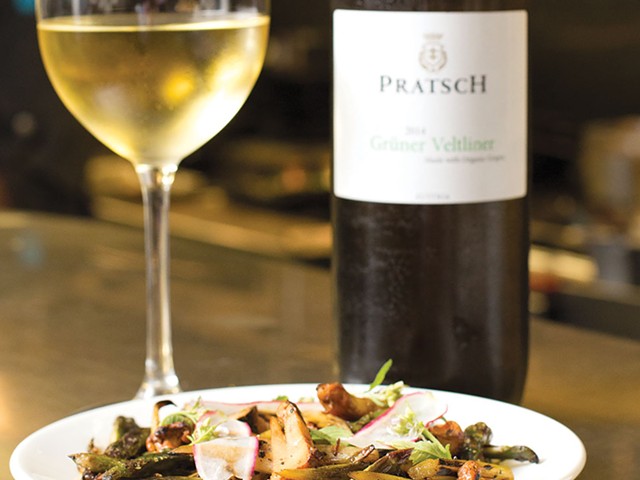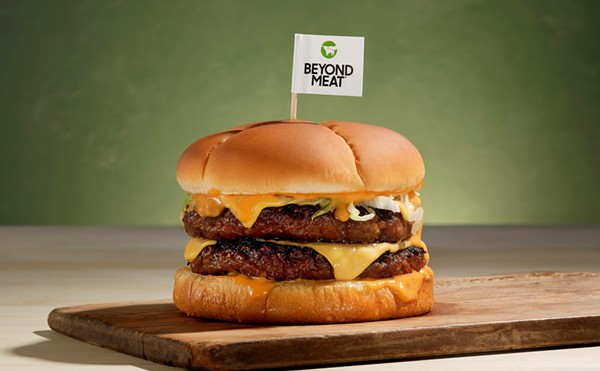A few years ago I wrote a song about a ghost that haunted a Kroger; it was the ghost of someone who had died after eating spoiled supermarket sushi, and its eternal mission was to warn others, lest they meet the same fate.
No, it wasn’t my best work, but the point was clear: Why would anyone ever eat sushi they found in a grocery store? Grocery stores are for bread and milk; sushi bars are for sushi. Pretty simple, right?
Well, not so fast: It seems modern times have changed the game — I later broke down and tried some sushi from a grocery, and guess what? It wasn’t too bad. Now it’s commonplace. To that end, I decided to test out a few around town to see just how far this supermarket sushi evolution has come.
First, I went to Kroger in Clifton — in honor of my song, of course — and walked out with a sampler that included a couple of small tekkamaki rolls, and four pieces of nigiri (tuna and salmon). Provided to the store by a company called AFC Franchise Corp., it was beautifully presented, looked and smelled inviting and didn’t hold back on ingredients, blending plenty of avocado with a couple of nice sauces, with one of the rolls topped with roe.
The cost? $12. That’s great value, even if it didn’t seem to have the same bold flavor profile you’d get from made-to-order sushi. Truth be told, while I enjoyed it, if I’d been craving sushi bar fare, that ready-to-serve sampler wouldn’t have quite satisfied my desires. It was good, but not great.
Next I went to Whole Foods in St. Matthews — if any chain is going to have good sushi, it has to be Whole Foods, right? I decided on a spicy tuna avocado roll, but the selection there was reasonable, featuring a range from basic nigiri to a pretty tempting specimen called a Red Dragon Crunch Roll, which was topped with fresh jalapeño slices.
When I opened up the plastic container, which was blander than the Kroger packaging, I noticed the avocado was beginning to show minor, brown spotting in a couple of places, but the plentiful tuna looked and smelled fresh. For $8.99, I got nine enormous pieces, good enough for a worthy lunch. The spicy orange sauce was not too spicy so as to overwhelm the rest of the ingredients, and the overall flavor was good. Respectable job by Genji, who provides the sushi for Whole Foods.
I decided to give the new Fresh Thyme grocery in St. Matthews a try as well, and I was surprised to find the chef there making sushi fresh — she even offered to make me something to order. I wanted to keep it fair, so I got a pre-made dynamite roll, with spicy fish that appeared to be tuna (what the roll is made with rotates, if I read the menu correctly), plus crab and avocado, and drizzled with orange sauce for a reasonable $6.95.
Provided by Arata Sushi, the offerings focus on rolls and party platters. The sushi comes in colorful plastic containers with the usual garnish of wasabi and ginger, protected by a little strip of plastic grass. My roll consisted of 10 medium-to-large pieces, and it was evident it hadn’t been sitting long. My guess is the chef had made it within the hour, as the textures and flavors were a bit more of what I was expecting than what I had at Kroger and Whole Foods. Still, it wasn’t a total home run — good, not great.
Here’s the deal with so-called supermarket sushi: Because it is refrigerated to maintain freshness, the flavor in the fish and vegetables becomes muted, and too often the rice takes on a weird texture, as if it is becoming a paste rather than made up of individual grains. Of course, not refrigerating it would be a risk, as raw fish sitting out at room temperature all day could ultimately lead a customer to a fate like the ghost in my song. (Not to mention, a resulting lawsuit for the store.)
In addition, cutting sushi just before serving it is not an exercise in procrastination — much of the fish’s flavor is waiting inside, and once cut, the meat begins to oxidize. Of course, one can only imagine that the fish we find in, say, a spicy tuna roll or Alaska roll at any market is also likely not the high-quality stuff your favorite chef seeks when stocking his bar.
My final conclusion here is that, in a pinch, supermarket sushi isn’t nearly as bad an idea as I once imagined it to be, and it’s generally good value, to boot. But when it’s all said and done, I prefer my sushi to be made to order, and served at proper temperatures. Sushi isn’t cheap — I want to get all the enjoyment out of it I can.







